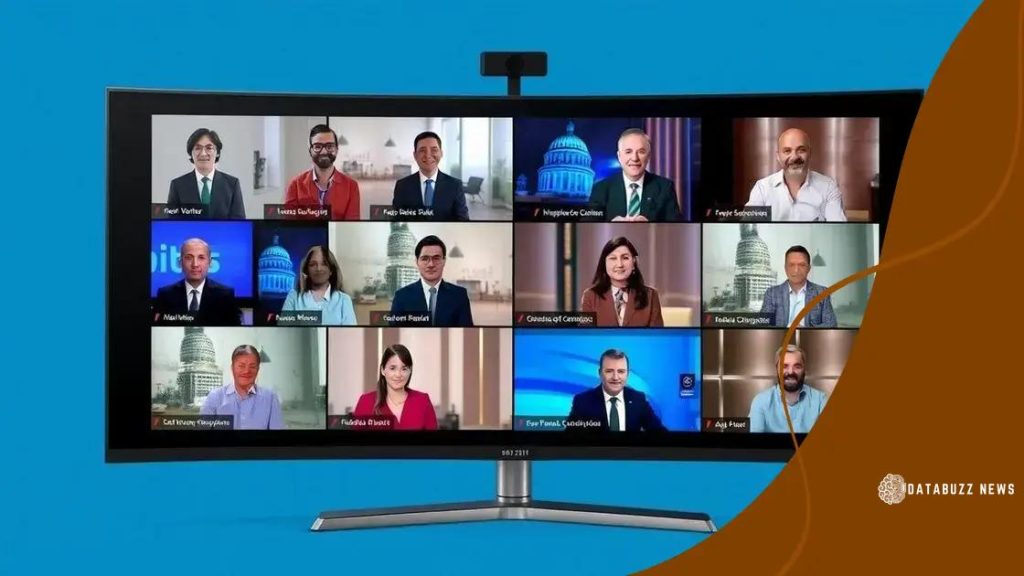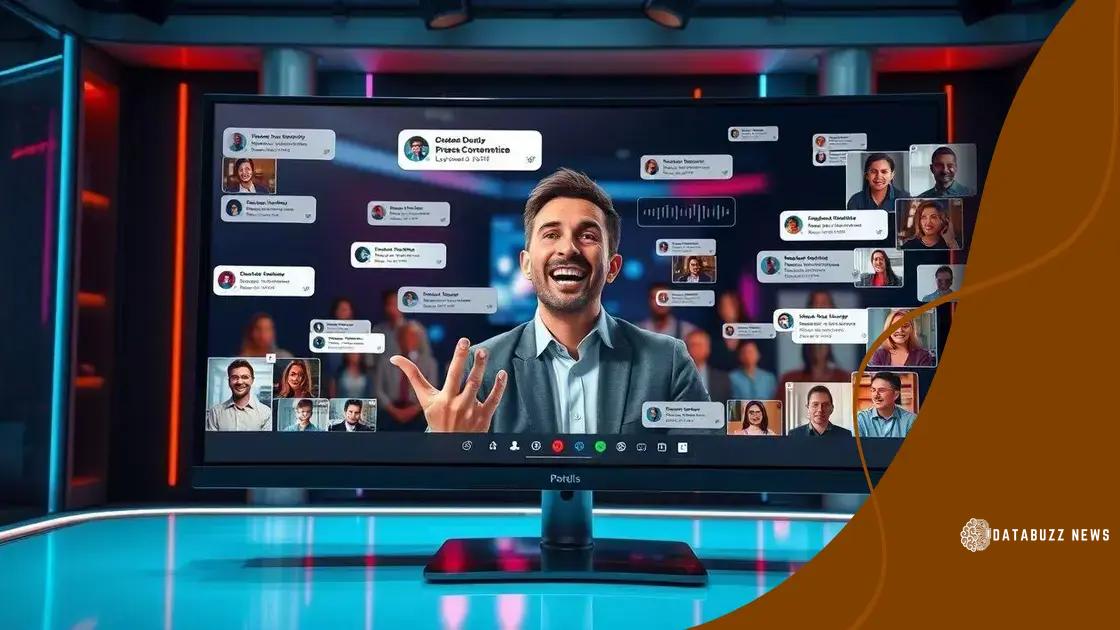Virtual press conferences: best practices for remote engagement

Virtual press conferences require effective technology tools, engaging content, and audience interaction strategies to enhance engagement and ensure successful communication with participants.
Virtual press conferences are becoming a staple in modern communication. Have you ever thought about how these events can engage your audience more effectively? Let’s dive into some best practices that can enhance your remote events.
Understanding the virtual press conference format
Understanding the virtual press conference format is crucial for effective communication in today’s digital age. These formats have created new opportunities for engaging with audiences, providing flexibility and immediate access to information.
Key Elements of Virtual Press Conferences
In a virtual press conference, certain key elements are essential for success. These include:
- Platform Selection: Choose a reliable platform that supports streaming and interaction.
- Agenda Setting: Outline clear topics and timelines to keep the conference focused.
- Engagement Tools: Utilize polls, Q&A sessions, and chat functions to involve attendees.
As we dive deeper into the format, it’s important to note that preparation is key. Having a tech checklist can minimize issues during the event. Ensure you have a robust internet connection and test all equipment beforehand.
Audience Considerations
Understanding your audience is vital. Audience demographics can influence how you present information. Consider their preferences for content delivery and interactivity. Engaging your audience through familiar platforms can create a more inviting atmosphere.
Additionally, think about time zones and availability. Scheduling your virtual press conference at an optimal time encourages greater attendance. Keeping these factors in mind can drastically improve audience engagement.
By embracing the virtual format, organizations can reach wider audiences without geographical barriers. The potential for feedback is also enhanced, as participants can share their thoughts in real-time. This dynamic interaction facilitates meaningful conversations and fosters relationships.
Key technology tools for seamless events
Choosing the right technology tools is vital for hosting seamless virtual press conferences. These tools facilitate communication, enhance engagement, and ensure a smooth flow of information.
Essential Technology Tools
To create an effective experience, consider including the following:
- Video Conferencing Platforms: Tools like Zoom or Microsoft Teams provide reliable video and audio quality.
- Webinar Software: Platforms such as GoToWebinar offer features like registration and analytics.
- Interactive Tools: Polls and Q&A features keep audiences engaged and involved during the event.
When selecting a platform, it is essential to evaluate its user-friendliness. A tool should not require extensive training for attendees, as ease of use encourages higher participation rates.
Additional Support Tools
In addition to core video conferencing software, other tools can enhance the experience. Streamlining communication with project management tools can make organizing the event easier. These can help track progress and ensure that all team members are aligned on tasks.
Social media integration is also important. Promoting your event on platforms like Twitter and LinkedIn can attract a wider audience. Use scheduling tools to ensure consistent messaging leading up to the conference.
A reliable internet connection stands out as one of the most crucial factors. Invest in good bandwidth to avoid interruptions. Testing your setup before the event helps identify potential issues early.
Tips for fostering audience interaction

Fostering audience interaction during a virtual press conference is key to keeping attendees engaged. Active involvement can lead to more meaningful discussions and greater retention of information.
Encouraging Participation
There are several effective strategies for encouraging participation from your audience. Using interactive elements adds a dynamic layer to the presentation:
- Live Polls: Incorporate polls to gather instant feedback. This gives attendees a voice and makes them feel valued.
- Q&A Sessions: Allocate time for questions. This allows the audience to clarify points that matter to them.
- Chat Features: Encourage attendees to use the chat for comments or questions during the presentation. This can create a lively atmosphere.
It’s important to foster a welcoming environment. Start by addressing the audience directly. A simple greeting can set a positive tone. Maintaining eye contact with the camera can also make participants feel more connected.
Utilizing Breakout Rooms
Breakout rooms can be a strategic way to facilitate smaller discussions. Divide attendees into smaller groups for focused conversations. Each group can tackle specific topics, leading to deeper engagement.
After breakouts, designate time for groups to share insights. This not only summarizes discussions but also encourages a sense of community. The use of feedback tools can help you gather insights on how participants felt about the interaction.
Lastly, remember to follow up. Sending a thank-you message or summary email after the event can keep the momentum going and show that you appreciate their participation.
Creating compelling content for online audiences
Creating compelling content for online audiences is essential for a successful virtual press conference. Engaging content captivates attendees and keeps their attention throughout the event.
Understanding Your Audience
Knowing your audience is the first step in crafting effective content. Consider their interests and needs. Tailoring your message to fit their preferences can create a more impactful experience.
- Research: Take time to understand what topics resonate with your audience.
- Demographics: Consider age, profession, and interests to fine-tune your content.
- Feedback: Tap into previous interactions to shape your current content.
Using relatable language and examples will also enhance engagement. Avoid jargon unless it is well-understood by your audience. Using stories or real-life examples can make content feel more personal and relatable.
Utilizing Visuals
Incorporating visuals is another key element. Images, videos, and infographics can break up text and illustrate points clearly. Dynamic visuals can help convey messages more effectively than text alone. Consider adding:
- Charts and Graphs: These provide clear visual data representations, making complex information easier to digest.
- Videos: Short, engaging videos can summarize or outline main topics quickly.
- Slide Presentations: Visually appealing slides keep information organized and can highlight key points.
Variety keeps the audience engaged. Combine different types of content to cater to various learning styles. Make sure to maintain a consistent theme and branding across all materials to enhance recognition.
Finally, ensure that your content addresses common questions or concerns. Anticipating audience needs will keep them engaged and foster a more interactive atmosphere.
Analyzing feedback for future improvements
Analyzing feedback after a virtual press conference is essential for making future events more effective. Collecting insights helps understand what worked well and what can be improved.
Gathering Feedback
Feedback can be collected through various methods, ensuring a comprehensive view of participant experiences. Consider these strategies for feedback collection:
- Surveys: Send out surveys via email immediately after the event. Keep questions concise and relevant.
- Polls: Use live polls during the session. This provides instant feedback and keeps attendees engaged.
- Follow-up Calls: Reach out to key participants for one-on-one feedback discussions. Personal interactions can yield deeper insights.
Collecting diverse feedback sources allows for different perspectives. Ensure that you ask specific questions that measure satisfaction and engagement levels.
Evaluating Feedback
Once feedback is collected, the next step is evaluation. Look for common themes that emerge from responses. Identifying patterns helps pinpoint areas needing improvement. For instance, if many attendees mention that sessions were too long, consider shortening them in future events.
Utilizing data analysis tools can aid in organizing and interpreting feedback effectively. Review metrics like attendee engagement rates and completion rates to gain a clearer picture. Comparing this data can show progress over time.
Finally, share the findings with your team. Discuss how insights can be translated into actionable strategies for the next event. This collaborative approach fosters innovation and continuous improvement.
In conclusion, effective virtual press conferences rely on careful planning, engaging technology, and continuous improvement through feedback. By understanding your audience and creating compelling content, you can significantly enhance engagement and make your event a success. Incorporating interactive elements will keep participants involved, while analyzing feedback ensures that future events are even better. With these strategies in mind, you’re well on your way to hosting impactful virtual press conferences.
FAQ – Frequently Asked Questions about Virtual Press Conferences
What technology tools are essential for a virtual press conference?
Essential tools include video conferencing platforms like Zoom, webinar software, and interactive tools for polls and Q&A.
How can I encourage audience interaction during my event?
Encourage interaction by using live polls, Q&A sessions, and chat features to create a dynamic and engaging experience.
Why is feedback important after a virtual press conference?
Feedback is crucial for understanding what worked well and identifying areas for improvement, helping you enhance future events.
What strategies can I use to create compelling content?
Know your audience, use relatable language, incorporate visuals, and keep the content engaging to maintain their interest.
